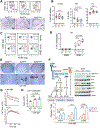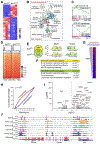A hotspot mutation in transcription factor IKZF3 drives B cell neoplasia via transcriptional dysregulation
- PMID: 33689703
- PMCID: PMC8034546
- DOI: 10.1016/j.ccell.2021.02.003
A hotspot mutation in transcription factor IKZF3 drives B cell neoplasia via transcriptional dysregulation
Abstract
Hotspot mutation of IKZF3 (IKZF3-L162R) has been identified as a putative driver of chronic lymphocytic leukemia (CLL), but its function remains unknown. Here, we demonstrate its driving role in CLL through a B cell-restricted conditional knockin mouse model. Mutant Ikzf3 alters DNA binding specificity and target selection, leading to hyperactivation of B cell receptor (BCR) signaling, overexpression of nuclear factor κB (NF-κB) target genes, and development of CLL-like disease in elderly mice with a penetrance of ~40%. Human CLL carrying either IKZF3 mutation or high IKZF3 expression was associated with overexpression of BCR/NF-κB pathway members and reduced sensitivity to BCR signaling inhibition by ibrutinib. Our results thus highlight IKZF3 oncogenic function in CLL via transcriptional dysregulation and demonstrate that this pro-survival function can be achieved by either somatic mutation or overexpression of this CLL driver. This emphasizes the need for combinatorial approaches to overcome IKZF3-mediated BCR inhibitor resistance.
Keywords: BCR signaling; CLL; IKZF3; NF-κB; murine mode.
Copyright © 2021 Elsevier Inc. All rights reserved.
Conflict of interest statement
Declaration of interests C.J.W. is an equity holder of Biontech, Inc. and receives research funding from Pharmacyclics. D.S.N. has been a consultant for H3 Biomedicine and received research funding from Celgene. J.A.B. reports receiving grant support and advisory board fees from Pharmacyclics, grant support, advisory board fees, and lecture fees from Gilead, advisory board fees from AstraZeneca, and lecture fees and travel support from Janssen. T.J.K. has received research funding and/or has served as an advisor to Ascerta/AstraZeneca, Celgene, Genentech/Roche, Gilead, Janssen, Loxo Oncology, Octernal Therapeutics, Pharmacyclics/AbbVie, TG Therapeutics, VelosBio, and Verastem. Cirmtuzumab was developed by T.J.K. and licensed by the University of California to Oncternal Therapeutics, Inc., which has provided stock/options to the university and T.J.K. All other authors do not have any relevant conflict of interest.
Figures






References
-
- Ahn IE, Chen Y-C, Underbayev C, Gaglione EM, Sun C, Soto S, Nierman P, Pirooznia M, and Wiestner A (2019). Diverging Clonal Evolution during Sequential Therapy with Chemoimmunotherapy Followed By BTK Inhibitors. In, (American Society of Hematology; Washington, DC: ).
-
- Billot K, Soeur J, Chereau F, Arrouss I, Merle-Beral H, Huang ME, Mazier D, Baud V, and Rebollo A (2011). Deregulation of Aiolos expression in chronic lymphocytic leukemia is associated with epigenetic modifications. Blood 117, 1917–1927. - PubMed
-
- Burger JA, Burger M, and Kipps TJ (1999). Chronic lymphocytic leukemia B cells express functional CXCR4 chemokine receptors that mediate spontaneous migration beneath bone marrow stromal cells. Blood 94, 3658–3667. - PubMed
Publication types
MeSH terms
Substances
Grants and funding
LinkOut - more resources
Full Text Sources
Other Literature Sources
Molecular Biology Databases
Research Materials

